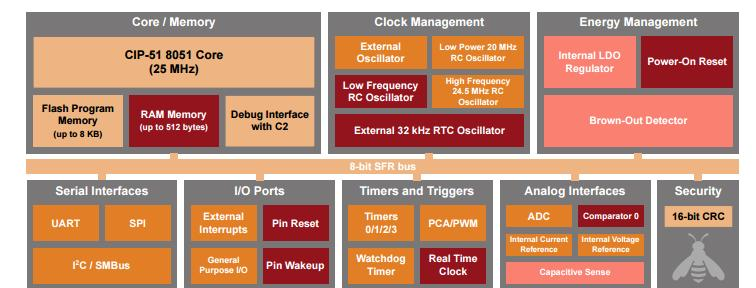基于Silicon labs8位MCU EFM8SB1主控器件的无线校园卡系统解决方案
 327
327
 拍明
拍明
概述
校园卡属于主动式电子标签,工作频率为2.4G,主要由MCU、无线通讯和外围电路组成,内置电源。通常一张卡的使用寿命为二年左右,而卡的封装模式是防拆卸性的,不能自行更换电池,因此对系统的功耗要求极高。要求mcu的休眠电流在1mA以下,同时PCBA安装在卡片内,需要PCB面积和PCBA体积小,系统采用的EFM8SB1系列MCU具有的0.5uA 睡眠电流以及3mm*3mm超小封装能非常好地满足以上两个苛刻要求。
优势
· Silicon labs 的8位MCU EFM8SB1 120uA/MHz运行功耗,0.5uA 睡眠电流,极低的功耗,有效延长电池的续航时间;3mm*3mm QFN20超小封装,以节省PCB面积,同时集成12位分辨率的ADC,可以实现对电池电压的精确检测,非常适用于校园卡系统。
【EFM8SB1】
EFM8 Sleepy Bee Family EFM8SB1 Data Sheet
The EFM8SB1, part of the Sleepy Bee family of MCUs, is the world’s most energy friendly 8-bit microcontrollers with a comprehensive feature set in small packages.
These devices offer lowest power consumption by combining innovative low energy techniques and short wakeup times from energy saving modes into small packages, making them well-suited for any battery operated applications. With an efficient 8051 core, 14 high-quality capacitive sense channels, and precision analog, the EFM8SB1 family is also optimal for embedded applications.

EFM8SB1 applications include the following:
• Touch pads / key pads
• Wearables
• Instrumentation panels
• Battery-operated consumer electronics
ENERGY FRIENDLY FEATURES
• Lowest MCU sleep current with supplybrownout (50 nA)
• Lowest MCU active current (150 μA / MHzat 24.5 MHz)
• Lowest MCU wake on touch averagecurrent (< 1 μA)
• Lowest sleep current using internal RTCand supply brownout (< 300 nA)
• Ultra-fast wake up for digital and analogperipherals (< 2 μs)
• Integrated LDO to maintain ultra-lowactive current at all voltages
Feature List
The EFM8SB1 highlighted features are listed below.
• Core:
• Pipelined CIP-51 Core
• Fully compatible with standard 8051 instruction set
• 70% of instructions execute in 1-2 clock cycles
• 25 MHz maximum operating frequency
• Memory:
• Up to 8 kB flash memory, in-system re-programmable from firmware.
• Up to 512 bytes RAM (including 256 bytes standard 8051 RAM and 256 bytes on-chip XRAM)
• Power:
• Internal LDO regulator for CPU core voltage
• Power-on reset circuit and brownout detectors
• I/O: Up to 17 total multifunction I/O pins:
• Flexible peripheral crossbar for peripheral routing
• 5 mA source, 12.5 mA sink allows direct drive of LEDs
• Clock Sources:
• Internal 20 MHz low power oscillator with ±10% accuracy
• Internal 24.5 MHz precision oscillator with ±2% accuracy
• Internal 16.4 kHz low-frequency oscillator or RTC 32 kHz crystal (RTC crystal not available on CSP16 packages)
• External crystal, RC, C, and CMOS clock options
• Timers/Counters and PWM:
• 32-bit Real Time Clock (RTC)
• 3-channel Programmable Counter Array (PCA) supporting PWM, capture/compare, and frequency output modes with watchdog timer function
• 4 x 16-bit general-purpose timers
• Communications and Digital Peripherals:
• UART
• SPI™ Master / Slave
• SMBus™ / I2C™ Master / Slave
• 16-bit CRC unit, supporting automatic CRC of flash at 256-byte boundaries
• Analog:
• Capacitive Sense (CS0)
• Programmable current reference (IREF0)
• 12-Bit Analog-to-Digital Converter (ADC0)
• 1 x Low-current analog comparator
• On-Chip, Non-Intrusive Debugging
• Full memory and register inspection
• Four hardware breakpoints, single-stepping
• Pre-loaded UART bootloader
• Temperature range -40 to 85 ºC
• Single power supply 1.8 to 3.6 V
• QSOP24, QFN24, QFN20, and CSP16 packages
With on-chip power-on reset, voltage supply monitor, watchdog timer, and
clock oscillator, the EFM8SB1 devices are truly standalone system-on-a-chip
solutions. The flash memory is reprogrammable in-circuit, providing non-volatile
data storage and allowing field upgrades of the firmware. The on-chip debugging
interface (C2) allows non-intrusive (uses no on-chip resources), full speed,
in-circuit debugging using the production MCU installed in the final
application. This debug logic supports inspection and modification of memory and
registers, setting breakpoints, single stepping, and run and halt commands. All
analog and digital peripherals are fully functional while debugging. Each device
is specified for 1.8 to 3.6 V operation. Devices are AEC-Q100 qualified (Grade
3) and are available in 16- pin CSP, 20-pin QFN, 24-pin QFN, or 24-pin QSOP
packages. All package options are lead-free and RoHS compliant. Note: CSP
devices can be handled and soldered using industry standard surface mount
assembly techniques. However, because CSP devices are essentially a piece of
silicon and are not encapsulated in plastic, they are susceptible to mechanical
damage and may be sensitive to light. When CSP packages must be used in an
environment exposed to light, it may be necessary to cover the top and sides
with an opaque material.
【手机校园一卡通】
手机校园一卡通指的是以“手机”为主要载体,在进行消费、身份认证及个人信息查询等功能时的应用模式,又名无线校园和校园手机一卡通。是将移动sim卡或电信uim卡与原校园ic卡两卡功能合设在一张频率为2.4g的rfid-sim卡上,能同时实现移动通信和消费刷卡的功能,是电信运营商推广的一种新型的身份认证和移动支付业务系统。每个用户可以保留原有手机号码、不更换手机,只要更换一个新的rfid-sim手机卡,不仅保留原有手机的通讯功能外,还可以使用手机在读卡设备上轻轻一挥,就可以实现小额消费、门禁、考勤等等扩展功能。
手机校园一卡通是将手机的应用和校园卡的功能结合在一起。应用于学校范畴内一卡通建设的新型解决方案。用户可以通过使用带有SIMPASS卡或RFID-SIM卡的手机,实现“校园一卡通”。基于手机的“校园一卡通”除了能实现传统基于IC卡的“校园一卡通”的所有功能外,还可以通过短信、手机WAP网站等方式在校园内实现图书馆、教务、财务、学工等多部门与教师/学生的信息互动,如:指令下达、信息反馈、意见上传等。可以通过打电话实现空中圈存,为教工/学生带来更为便捷的工作生活方式。随着智能手机技术的不断发展。手机扩展功能的不断完善.采用手机实现一卡通更利于信息的整合;另外。在人们的生活中,手机几乎已成为必备的通讯工具,如果采用手机作为一卡通实施的媒介,可以在不产生携带负担的基础上。节省大量用于制造IC卡的资源,创建更为低碳、环保、便捷的生活新方式
责任编辑:Davia
【免责声明】
1、本文内容、数据、图表等来源于网络引用或其他公开资料,版权归属原作者、原发表出处。若版权所有方对本文的引用持有异议,请联系拍明芯城(marketing@iczoom.com),本方将及时处理。
2、本文的引用仅供读者交流学习使用,不涉及商业目的。
3、本文内容仅代表作者观点,拍明芯城不对内容的准确性、可靠性或完整性提供明示或暗示的保证。读者阅读本文后做出的决定或行为,是基于自主意愿和独立判断做出的,请读者明确相关结果。
4、如需转载本方拥有版权的文章,请联系拍明芯城(marketing@iczoom.com)注明“转载原因”。未经允许私自转载拍明芯城将保留追究其法律责任的权利。
拍明芯城拥有对此声明的最终解释权。




 产品分类
产品分类















 2012- 2022 拍明芯城ICZOOM.com 版权所有 客服热线:400-693-8369 (9:00-18:00)
2012- 2022 拍明芯城ICZOOM.com 版权所有 客服热线:400-693-8369 (9:00-18:00)


